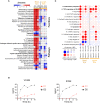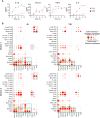Cell type- and time-dependent biological responses in ex vivo perfused lung grafts
- PMID: 37465668
- PMCID: PMC10351384
- DOI: 10.3389/fimmu.2023.1142228
Cell type- and time-dependent biological responses in ex vivo perfused lung grafts
Abstract
In response to the increasing demand for lung transplantation, ex vivo lung perfusion (EVLP) has extended the number of suitable donor lungs by rehabilitating marginal organs. However despite an expanding use in clinical practice, the responses of the different lung cell types to EVLP are not known. In order to advance our mechanistic understanding and establish a refine tool for improvement of EVLP, we conducted a pioneer study involving single cell RNA-seq on human lungs declined for transplantation. Functional enrichment analyses were performed upon integration of data sets generated at 4 h (clinical duration) and 10 h (prolonged duration) from two human lungs processed to EVLP. Pathways related to inflammation were predicted activated in epithelial and blood endothelial cells, in monocyte-derived macrophages and temporally at 4 h in alveolar macrophages. Pathways related to cytoskeleton signaling/organization were predicted reduced in most cell types mainly at 10 h. We identified a division of labor between cell types for the selected expression of cytokine and chemokine genes that varied according to time. Immune cells including CD4+ and CD8+ T cells, NK cells, mast cells and conventional dendritic cells displayed gene expression patterns indicating blunted activation, already at 4 h in several instances and further more at 10 h. Therefore despite inducing inflammatory responses, EVLP appears to dampen the activation of major lung immune cell types, what may be beneficial to the outcome of transplantation. Our results also support that therapeutics approaches aiming at reducing inflammation upon EVLP should target both the alveolar and vascular compartments.
Keywords: inflammation; lung; monocyte/macrophages; single cell RNA-seq; transplantation.
Copyright © 2023 Gouin, Vu Manh, Jouneau, Bevilacqua, De Wolf, Glorion, Hannouche, Urien, Estephan, Roux, Magnan, Le Guen, Da Costa, Chevalier, Descamps, Schwartz-Cornil, Dalod and Sage.
Conflict of interest statement
The authors declare that the research was conducted in the absence of any commercial or financial relationships that could be construed as a potential conflict of interest.
Figures






Similar articles
-
Optimal ex vivo lung perfusion techniques with oxygenated perfusate.J Heart Lung Transplant. 2017 Apr;36(4):466-474. doi: 10.1016/j.healun.2016.10.014. Epub 2016 Oct 29. J Heart Lung Transplant. 2017. PMID: 27914896
-
Cellular Ex Vivo Lung Perfusion Beyond 1 Hour May Improve Marginal Donor Lung Assessment.J Surg Res. 2020 Jun;250:88-96. doi: 10.1016/j.jss.2019.09.073. Epub 2020 Feb 3. J Surg Res. 2020. PMID: 32028151
-
Is it possible to further improve the function of pulmonary grafts by extending the duration of lung reconditioning using ex vivo lung perfusion?Perfusion. 2013 Jul;28(4):322-7. doi: 10.1177/0267659113479424. Epub 2013 Feb 22. Perfusion. 2013. PMID: 23436723
-
Ex vivo lung graft perfusion.Anaesth Crit Care Pain Med. 2016 Apr;35(2):123-31. doi: 10.1016/j.accpm.2015.09.006. Epub 2015 Dec 30. Anaesth Crit Care Pain Med. 2016. PMID: 26746565 Review.
-
The Conversional Efficacy of Ex Vivo Lung Perfusion and Clinical Outcomes in Patients Undergoing Transplantation of Donor Lungs by Ex Vivo Lung Perfusion: A Meta-Analysis.Ann Transplant. 2019 Dec 27;24:647-660. doi: 10.12659/AOT.919242. Ann Transplant. 2019. PMID: 31879416 Free PMC article.
Cited by
-
SARS-CoV2 infection in whole lung primarily targets macrophages that display subset-specific responses.Cell Mol Life Sci. 2024 Aug 15;81(1):351. doi: 10.1007/s00018-024-05322-z. Cell Mol Life Sci. 2024. PMID: 39147987 Free PMC article.
-
Transcriptomic Signatures in Lung Allografts and Their Therapeutic Implications.Biomedicines. 2024 Aug 7;12(8):1793. doi: 10.3390/biomedicines12081793. Biomedicines. 2024. PMID: 39200257 Free PMC article. Review.
References
Publication types
MeSH terms
LinkOut - more resources
Full Text Sources
Medical
Molecular Biology Databases
Research Materials

